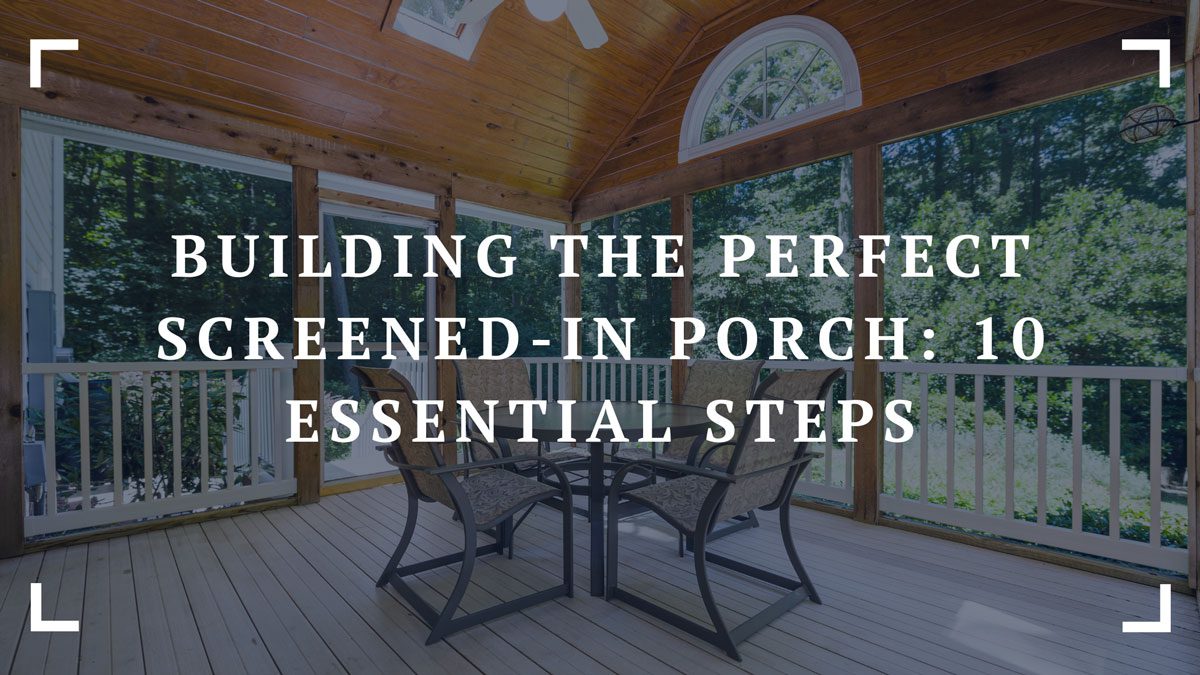A screened-in porch is more than just an additional space; it’s a versatile area that seamlessly combines the comforts of indoor living with the refreshing ambiance of the outdoors. This extension to your home serves as a functional and inviting retreat, providing an escape from bugs while allowing you to bask in the natural surroundings.
Constructing a superior screened-in porch demands thorough preparation, adherence to crucial steps, and the collaboration of a skilled builder.
Regardless of whether you envision a quiet corner for relaxation or an expansive area for gatherings, the process of bringing your dream screened-in porch to life involves a series of practical considerations and informed decisions.

Building a Screened-in Porch in 10 Steps
A screened-in porch adds value to your home by expanding the living area and offering a place to unwind or entertain guests throughout the year.
It’s an opportunity to create a haven where you can enjoy the outdoors without the inconvenience of pests or adverse weather conditions.
From the initial design stages to selecting the right materials and incorporating functional elements, each step contributes significantly to the success and functionality of your screened-in porch.
1. Initial Planning and Design
Begin by envisioning the specific activities you plan to enjoy on your screened-in porch. Consider factors such as the direction of sunlight, prevailing winds, and the surrounding landscape to maximize comfort and usability throughout the day.
Sketch multiple layout options, experimenting with furniture placement and functional zones to ensure an efficient use of space that aligns with your lifestyle.
2. Legal Compliance and Permits
Consult local building authorities or a professional to confirm zoning restrictions and necessary permits. Take note of setback requirements, height limitations, and any special regulations governing structures close to property lines.
Ensure that your builder is well-versed in these regulations and can assist in navigating the permit process smoothly.
3. Choosing the Right Materials
Beyond aesthetics, prioritize durability and maintenance needs when selecting materials. Consider factors like the porosity of wood, resistance to pests and rot, and the longevity of different materials in your climate.
Research the sustainability of materials as well, aiming for eco-friendly options that contribute to a greener footprint.
4. Finding the Best Builder
Interview prospective builders in detail, asking about their experience with similar projects and their familiarity with various materials.
Assess their communication style, responsiveness, and willingness to collaborate on design ideas. Request a detailed breakdown of costs, ensuring transparency and clarity in the pricing structure.
5. Check References and Past Work
Inquire about the builder’s work ethic, adherence to timelines, and ability to handle unforeseen challenges. Check references to gather insights into the builder’s professionalism, problem-solving skills, and overall client satisfaction. Visiting completed projects allows you to observe craftsmanship and attention to detail firsthand.
6. Detailed Contract and Scope of Work
Ensure the contract includes specifics on warranties, permits, cleanup responsibilities, and dispute resolution procedures.
Discuss potential scenarios such as project delays or material substitutions, ensuring they are addressed in the contract to avoid misunderstandings later. Review the payment schedule and verify that it aligns with project milestones.
7. Incorporating Functional Features
Discuss the placement of electrical outlets strategically to accommodate various appliances and devices. Plan for sufficient lighting that suits different activities and creates ambiance. Consider incorporating outdoor-rated ceiling fans for improved air circulation and a more comfortable environment.
8. Pay Attention to Ventilation and Airflow
Discuss the options for adjustable screens, windows, or vents that can be opened or closed as needed with your screen porch contractor. Consider installing a skylight or incorporating a vaulted ceiling design to enhance natural airflow and illuminate the space during daylight hours. Ensure the design maximizes cross-ventilation for optimal comfort.
9. Maintenance and Upkeep
Seek guidance from your builder on recommended maintenance routines for the materials used. Enquire about protective treatments or sealants that can prolong the lifespan of the porch components.
Discuss the importance of periodic inspections to identify and address any issues before they escalate.
10. Regular Communication with the Builder
Establish a communication schedule with your builder to receive updates on progress, address any concerns promptly, and make necessary decisions in a timely manner. Schedule regular site visits or virtual meetings to stay informed about the construction process and ensure it aligns with your vision.
Conclusion
Creating an exceptional screened-in porch is a journey that blends practicality with aesthetic appeal. It’s not just about creating a structure but curating an environment that seamlessly merges with your lifestyle while embracing the natural surroundings. Every decision made in this process, from the initial sketches to the final touches, plays a crucial role in shaping a space where you’ll craft enduring memories.
By adhering to the guidelines and investing thought, time, and effort into each phase, you’re not just building a porch; you’re creating an extension of your home that encapsulates comfort, functionality, and beauty.
It’s a space where morning coffees will be savored, family dinners will be enjoyed, and cherished moments with loved ones will be created against the backdrop of nature’s serenity.
So, embrace this process, communicate openly with your builder, and savor the anticipation of the haven you’re about to create.


